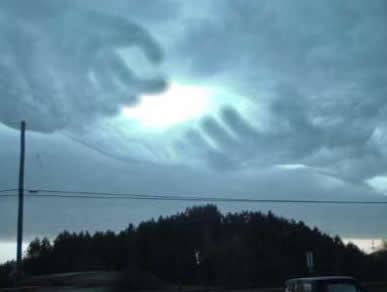

Altocumulus Undulatus Asperatus is a rare, newly recognized cloud formation. It is the first new formation added to the International Cloud Atlas of the World Meteorological Organization since 1951.
Margaret LeMone, a cloud expert with the National Center for Atmospheric Research has taken photos of asperatus clouds for 30 years, and considers it a likely new cloud type. On June 20, 2006 Jane Wiggins took a picture of asperatus clouds from the window of a downtown office building in Cedar Rapids, Iowa. In 2009 Gavin Pretor-Pinney, founder of the Cloud Appreciation Society, came across the image and began working through the Royal Meteorological Society to promote the cloud type. Wiggins' photograph was posted on the National Geographic website on June 4, 2009.
The fallstreak hole is a large circular gap that usually appears in cirrocumulus or altocumulus clouds. Such holes are formed when the water temperature in the clouds is below freezing but the water has not frozen yet due to the lack of ice nucleation particles. When a portion of the water does start to freeze it will set off a domino effect, due to the Bergeron process, causing the water vapor around it to freeze and fall to the earth as well. This leaves a large, often circular, hole in the cloud.
It is believed that a disruption in the stability of the cloud layer, such as that caused by a passing jet, may induce the domino process of evaporation which creates the hole. Such clouds are not unique to one geographic area and have been photographed from the United States to Russia.